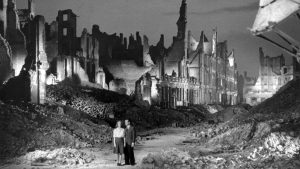I’ll keep my commentary short, but wanted to share a few words before we meet to discuss this extraordinary film, Wolfgang Staudte’s Murderers Are Among Us (1946). Warning: spoilers ahead.
The film comes out of Berlin and the immediate aftermath of the war – and it tells a story that, much like Rome Open City, reflects on the experience of the war. Susanne Wallner returns from a concentration camp looking like she just got back from a Mediterranean cruise. She discovers Dr. Hans Mertens living in her apartment. He’s scarred by the war. Crazy, disheveled, a drunkard. The neighbors are scandalized. He spends his days wandering the rubble-strewn streets and visiting the cabarets, while she begins to draw again. Suzanne falls in love with Hans, but he doesn’t know if he can love again. So, #1, we have a love story.
But it’s 1945 in war-scarred Berlin. Things aren’t going to be so easy for these lovebirds. It turns that Hans’ old captain is still alive, Ferdinand Brückner. Alive and thriving in postwar Berlin, turning helmets into cooking pots. Story #2, revenge. Will Hans kill Brückner, who deserves to die (Mertens thinks) for crimes of war…
We can take time to discuss what the story means together. I want to say a few words about the film’s style. The lighting, the cinematography, the soundscape all deserve some close attention. We’ll take a look at some striking compositions: canted shots, shadows looming over figures, evocative lighting, high angles. Staudte made his film in the shadow of the Nazi experiment (more on this when we get together), but he emphatically rejected the film styles of the Nazi period. His film harkens back to the styles (and the themes) of Weimar (that is pre-Nazi) German cinema (think the films of Fritz Lang, for example). The truth is out there, but it is obscure, hard to read. And moral corruption is everywhere. The answer here – see #1 – is romantic love. But it will not be so easy to clear the record…

